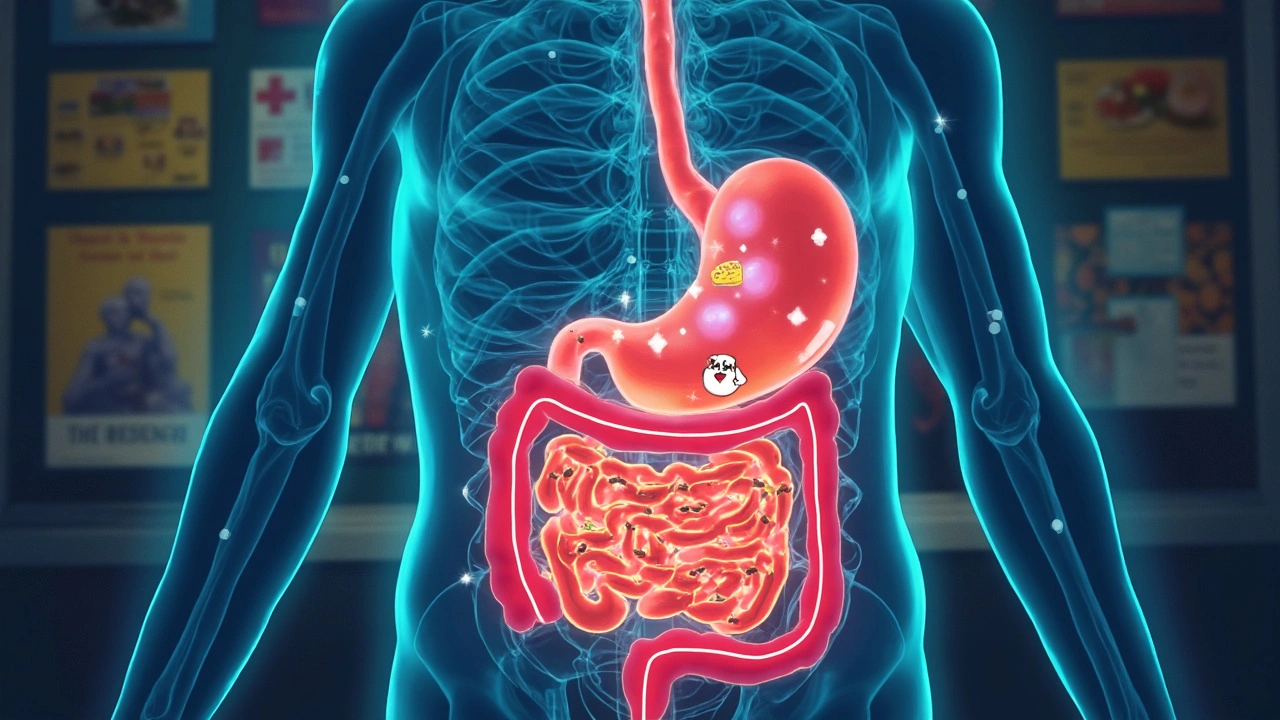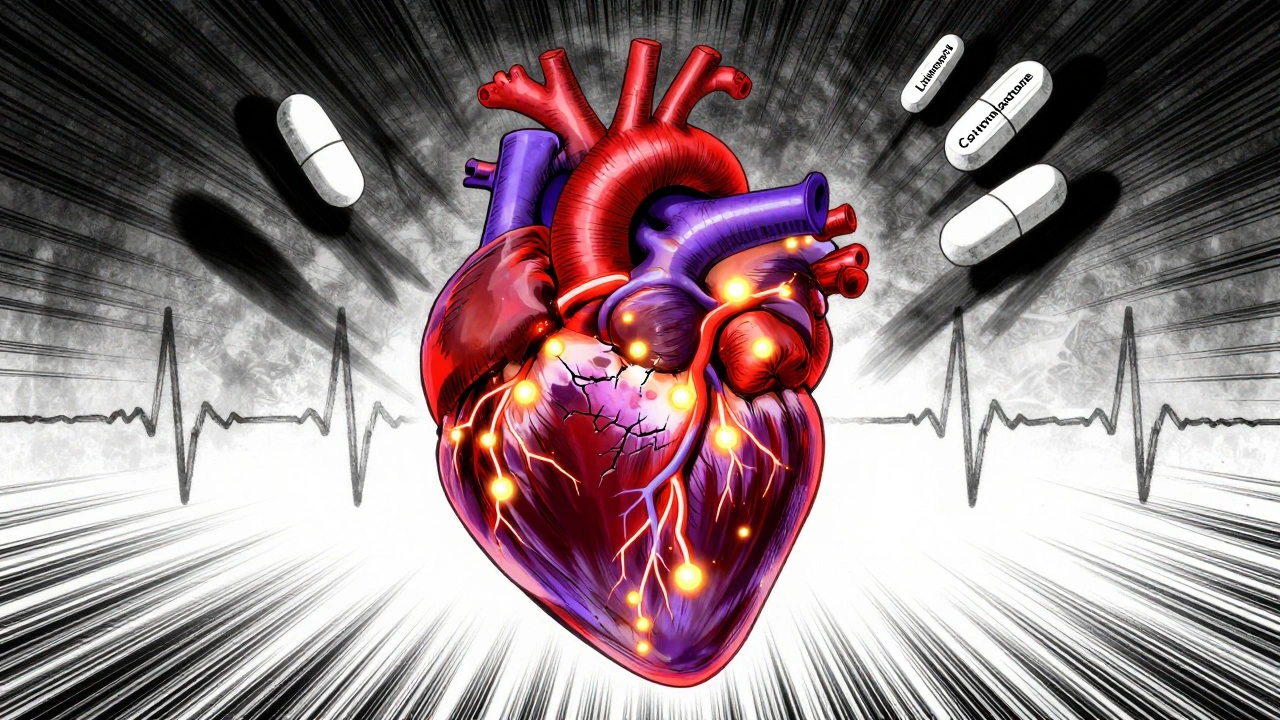Nausea and Lactose Intolerance: What You Need to Know

Feeling sick to your stomach after a cheesy pizza? You're probably wondering if it's the food or just bad luck. Nausea can hit hard when your body can't handle lactose, the sugar found in milk and dairy. But here’s the thing—most people brush it off or confuse it with just being ‘sensitive’ to food.
If you notice that milk, ice cream, lattes, or even that sneaky slice of lasagna leaves you queasy, there's a good chance your gut can't break down lactose properly. It’s not just you; around 65% of adults worldwide have at least some trouble digesting dairy. Your digestive system needs an enzyme called lactase to turn lactose into something your body can use. When you don’t have enough, that lactose sticks around in your gut, causing all sorts of chaos—including nausea.
This isn’t just about having an upset stomach. Your body sends out its own SOS when lactose lingers, and nausea might be your first warning sign. Understanding this link can help you take control and feel better after meals.
- What Actually Causes the Nausea?
- Spotting Lactose Intolerance Symptoms
- Practical Ways to Feel Better
- What Actually Works: Tips and Myths
What Actually Causes the Nausea?
So, what’s really going on inside your body when you feel queasy after eating dairy? It all comes down to an enzyme called lactase. When you don’t have enough lactase in your small intestine, your body can’t break down lactose (the main sugar in dairy). That undigested lactose doesn’t just sit quietly—it moves into your colon, where things start to get uncomfortable.
Here’s the simple version: in your colon, bacteria chow down on that extra lactose. This process creates gas, acids, and other byproducts. That chemical chaos can irritate your gut, mess with your stomach lining, and trigger nausea. Some people will also get cramping, bloating, or diarrhea, but for others, nausea stands out as the main warning sign.
Check out just how common this is in adults around the world:
| Region | % of Adults with Lactose Intolerance |
|---|---|
| Asia | 90% |
| Africa | 70-80% |
| South America | 60-70% |
| Northern Europe | 5-15% |
But why do you specifically feel nausea? That uncomfortable feeling is your body’s way of telling you something’s off in your digestive system. The build-up of gas and acids signals your brain to slow things down—or even empty your stomach. It’s a gut-brain alarm, asking you to stop adding more stress to your system for now.
Bottom line: If dairy regularly makes you nauseous, it’s likely because of this missing enzyme, a backup in your gut, and your body’s natural alarm system reacting. That’s why just popping an antacid won’t solve the issue—it’s not about stomach acid, but about undigested lactose causing trouble downstream.
Spotting Lactose Intolerance Symptoms
Think you just had some bad milk? Maybe, but lactose intolerance comes with a bundle of signs that go beyond a weird-tasting latte. Nausea is a big one, often kicking in less than two hours after eating dairy. But it's rarely solo—your stomach might cramp up, you could feel bloated, or you might spend some quality time in the bathroom. Sometimes people ignore these symptoms or think it’s just a fluke, but there’s a definite pattern when dairy is the culprit.
Here’s what to watch for if you’re questioning whether nausea and dairy are linked for you:
- Nausea (often soon after eating dairy)
- Bloating or feeling “full” in a bad way
- Stomach pain or cramps
- Diarrhea or loose stools
- Gas (yeah, it can get gassy)
A 2023 report from the National Institute of Diabetes and Digestive and Kidney Diseases says that about 68% of people around the world have trouble digesting lactose after childhood. Here’s something most folks don’t realize: the amount of enzyme lactase in your gut drops with age, which can turn cheese lovers into cheese avoiders over time.
"You don’t have to cut out all dairy right away, but if you’re seeing the same issues after eating cheese, milk or ice cream, it’s probably time to take a closer look." — Dr. Jennifer Coyle, Mayo Clinic
These symptoms usually show up within 30 minutes to two hours after you eat something with lactose. Keep an eye on recurring problems; a food diary can help spot connections you might miss otherwise. Some people get hit with every symptom, while others just feel a little sick. It’s all about your body’s lactase levels.
| Symptom | How Soon It Starts | How Common |
|---|---|---|
| Nausea | 30-120 minutes | Very Common |
| Bloating | 30-120 minutes | Very Common |
| Stomach Cramps | 30-120 minutes | Common |
| Diarrhea | 1-3 hours | Common |
| Gas | 1-3 hours | Common |
If you always feel sick after yogurt or a creamy pasta, there’s a strong chance lactose intolerance is to blame. Not everyone gets all the symptoms, but nausea is one of the first red flags that something’s up. If you’re suspicious, the next step is smart changes to see what helps.

Practical Ways to Feel Better
If you’re tired of feeling sick to your stomach every time you eat or drink dairy, there are some no-nonsense steps you can take to actually feel better. Here are simple things that make a real difference for lactose intolerance and nausea:
- Read labels: Dairy sneaks into everything from salad dressings to instant soups. Watch for words like “whey,” “curds,” “milk solids,” and “casein” if you’re trying to dodge lactose.
- Pick lactose-free options: Supermarkets stock lactose-free milk, cheese, and even ice cream now. These taste almost the same and usually cost just a bit more.
- Try lactase supplements: These handy pills or drops give your gut the lactase enzyme it’s missing. Pop one with your first bite of dairy to help break down lactose—some brands really work, especially for smaller portions.
- Dose matters: Most people with lactose intolerance can handle small amounts of dairy (like a splash of milk in coffee) without trouble. Trying to shove down a milkshake is a whole different story.
- Stick to hard cheeses or yogurt: Aged cheeses (like cheddar, parmesan, swiss) lose most of their lactose during the aging process. Yogurt has live bacteria that help digest lactose, so it’s usually easier on your stomach than milk.
- Eat with other food: Dairy is less likely to make you nauseous if you eat it with a meal—empty stomachs mean less buffer for your gut.
- Stay hydrated: If nausea hits, sipping water helps. Dehydration makes stomach issues worse, so don’t let it sneak up on you.
For those who like hard facts, check out this simple breakdown of lactose content in common dairy foods:
| Dairy Food | Average Lactose per Serving |
|---|---|
| Milk (1 cup) | 12g |
| Yogurt (1 cup) | 5g |
| Cheddar Cheese (1 oz) | 0.1g |
| Ice Cream (1/2 cup) | 6g |
| Lactose-free Milk (1 cup) | 0g |
If you’re still getting nausea even when you’re careful, it’s worth keeping a simple food diary for a week or so. Tracking what you eat and how you feel afterwards helps spot sneaky patterns and triggers. It’s not fun, but it’s way better than guessing and hoping for the best.
What Actually Works: Tips and Myths
If you keep running into nausea and stomach problems after eating dairy, there are some tricks that actually help—and others that just waste your time. Let’s sort out what really makes a difference if you’re dealing with lactose intolerance.
- Go for lactose-free options: These aren’t just hype. Lactose-free milk and cheese have lactase enzyme added in, so your gut doesn’t have to do the heavy lifting. You get all the taste, none of the nausea.
- Don’t fear small amounts: Many people who are lactose intolerant can handle about 12 grams of lactose at once (that’s roughly a glass of milk), especially if it’s with food. You often don’t have to avoid all dairy—just know your body’s limit.
- Lactase supplements help: These pills (or drops) add the missing enzyme to your digestive system. Pop one right before eating dairy, and you’re less likely to feel sick. Still, they’re not magic, so pay attention to your symptoms.
- Watch for hidden lactose: Dairy slips into things like salad dressings, sandwich bread, and processed snacks. If you're still feeling queasy, check those nutrition labels for words like "whey," "curds," or "milk solids."
Now, let’s crush some myths:
- “Hard cheeses are just as bad as milk” — False: Most hard cheeses (like cheddar or parmesan) have almost no lactose. You might be able to eat them without any nausea or lactose intolerance drama.
- “Yogurt is off-limits” — Nope: Many yogurts are easier to digest because their bacteria munch away at most of the lactose. Full-fat and Greek yogurts are usually safer bets.
- “Cutting dairy cures everything” — Not always: If your only issue is with dairy digestion, ditching all dairy is a last resort. Try tweaks first, like switching milk or spacing out dairy treats.
Here’s a quick look at how much lactose is in common foods, so you know what to expect:
| Food | Average Lactose (g/serving) |
|---|---|
| Milk (1 cup) | 12 |
| Cheddar Cheese (1 oz) | 0.02 |
| Greek Yogurt (6 oz) | 2–4 |
| Ice Cream (1/2 cup) | 4–6 |
| Butter (1 Tbsp) | 0.01 |
If nausea keeps popping up even after these changes, talk with a doctor. Sometimes, your gut needs more than just a dietary swap. But for most, tackling lactose intolerance just means a few simple swaps and learning what works for you.






Comments
Jordan Corry
April 30, 2025 AT 16:10Bro I used to chug milk like it was water until my stomach started staging a coup. Now I can’t even look at ice cream without my gut screaming for mercy. Lactase pills? Game changer. Pop one before pizza and boom - no more midnight bathroom marathons. 🤘
Mohamed Aseem
May 1, 2025 AT 05:20Stop pushing this dairy fearmongering. Humans evolved to drink milk. If your body can’t handle it, maybe you’re just weak. Also, why are we treating lactose like it’s a plague? It’s sugar. Sugar’s fine. It’s your weak gut that’s the problem.
Steve Dugas
May 1, 2025 AT 13:33There is no such thing as lactose intolerance - only poor dietary discipline. The data cited is misleading. Lactase persistence is the norm in populations with pastoral histories. Your nausea is psychological. You’ve been conditioned to associate dairy with discomfort. Fix your mindset. Not your diet.
Paul Avratin
May 3, 2025 AT 05:14As someone who’s spent years navigating the intersection of gastroenterology and cultural nutrition, I find this post reductive. The lactose intolerance narrative ignores epigenetic adaptations across diasporic populations. In South Asia, for example, fermentation practices have co-evolved with dairy consumption - yogurt isn’t a workaround, it’s an evolutionary adaptation. The real issue is industrialized dairy processing, not biology.
Brandi Busse
May 3, 2025 AT 21:13Okay but have you ever tried just not eating dairy at all like a normal person why do you need all these supplements and lactose free milk and reading labels like its a spy mission i just stopped eating cheese and now i feel like a new human no drama no pills no nothing
Colter Hettich
May 4, 2025 AT 04:45It’s fascinating - the way modernity has severed us from ancestral metabolic wisdom. The lactase enzyme, once a transient trait in adulthood, has been artificially prolonged in Northern European populations through selective pressure - yet we now treat its absence as a pathology. This post, while clinically accurate, fails to interrogate the cultural hegemony of dairy as a nutritional default. We’ve normalized the abnormal.
Prem Mukundan
May 5, 2025 AT 20:29You people act like lactose intolerance is some rare condition. In India, 90% of us can’t digest milk. We’ve been using plant-based alternatives for centuries - almond milk, coconut milk, even horse gram milk in Ayurveda. You’re just late to the game. Stop acting like dairy is essential. It’s not. Your body is telling you the truth.
Leilani Johnston
May 6, 2025 AT 14:03i used to think i was just bad with food until i started keeping a journal and realized every time i had a latte or mac and cheese i felt like i was gonna puke. then i tried lactose free milk and it was like my stomach threw me a parade. also i found out i can eat greek yogurt just fine - turns out the bacteria do the work for you. so if you’re sick after dairy, don’t just blame yourself - test it out. you might be surprised.
Jensen Leong
May 6, 2025 AT 22:30Thank you for this clear, evidence-based overview. I appreciate the inclusion of regional prevalence data - it contextualizes what is often dismissed as a personal quirk. For those considering supplements, I recommend choosing ones with 9000 FCC units of lactase and taking them 15 minutes before ingestion. Consistency matters more than quantity. And yes - butter is nearly lactose-free. Many overlook that.
Kelly McDonald
May 7, 2025 AT 08:07Y’all are overcomplicating this. If your stomach turns into a war zone after cheese, just… don’t eat cheese. Try oat milk. Try almond yogurt. Try life. You don’t need to be a scientist to figure out your body’s vibe. I went from daily nausea to feeling like I’d been given a second chance at food. It’s not a diet. It’s self-respect.
Joe Gates
May 9, 2025 AT 06:48I used to think I was just a sensitive person, you know? Like, maybe I was too emotional or something. But once I stopped blaming myself and started looking at the patterns - the timing, the foods, the symptoms - it all clicked. Now I eat dairy like it’s a special occasion dessert, not a daily habit. And honestly? My whole life improved. Less bloating, less guilt, more energy. It’s not about restriction. It’s about alignment. You’re not broken. You’re just tuned to a different frequency. And that’s okay. More than okay - it’s powerful.